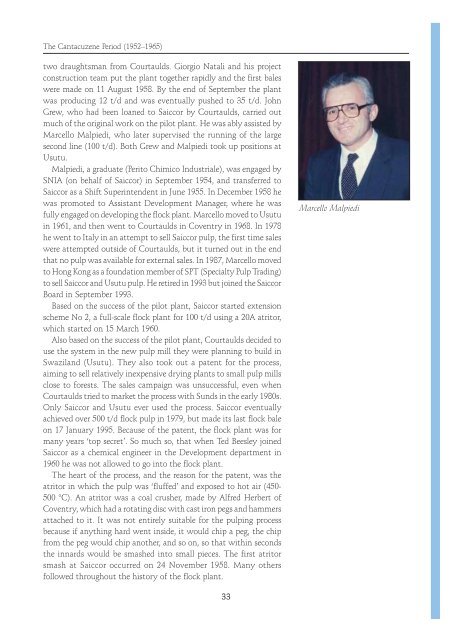Create successful ePaper yourself
Turn your PDF publications into a flip-book with our unique Google optimized e-Paper software.
<strong>The</strong> Cantacuzene Period (1952–1965)<br />
two draughtsman from Courtaulds� Giorgio Natali and his project<br />
construction team put the plant together rapidly and the first bales<br />
were made on 11 August 1958� By the end of September the plant<br />
was producing 12 t/d and was eventually pushed to 35 t/d� John<br />
Grew, who had been loaned to <strong>Saiccor</strong> by Courtaulds, carried out<br />
much of the original work on the pilot plant� He was ably assisted by<br />
Marcello Malpiedi, who later supervised the running of the large<br />
second line (100 t/d)� Both Grew and Malpiedi took up positions at<br />
Usutu�<br />
Malpiedi, a graduate (Perito Chimico Industriale), was engaged by<br />
SNIA (on behalf of <strong>Saiccor</strong>) in September 1954, and transferred to<br />
<strong>Saiccor</strong> as a Shift Superintendent in June 1955� In December 1958 he<br />
was promoted to Assistant Development Manager, where he was<br />
fully engaged on developing the flock plant� Marcello moved to Usutu<br />
in 1961, and then went to Courtaulds in Coventry in 1968� In 1978<br />
he went to Italy in an attempt to sell <strong>Saiccor</strong> pulp, the first time sales<br />
were attempted outside of Courtaulds, but it turned out in the end<br />
that no pulp was available for external sales� In 1987, Marcello moved<br />
to Hong Kong as a foundation member of SPT (Specialty Pulp Trading)<br />
to sell <strong>Saiccor</strong> and Usutu pulp� He retired in 1993 but joined the <strong>Saiccor</strong><br />
Board in September 1993�<br />
Based on the success of the pilot plant, <strong>Saiccor</strong> started extension<br />
scheme No 2, a full-scale flock plant for 100 t/d using a 20A atritor,<br />
which started on 15 March 1960�<br />
Also based on the success of the pilot plant, Courtaulds decided to<br />
use the system in the new pulp mill they were planning to build in<br />
Swaziland (Usutu)� <strong>The</strong>y also took out a patent for the process,<br />
aiming to sell relatively inexpensive drying plants to small pulp mills<br />
close to forests� <strong>The</strong> sales campaign was unsuccessful, even when<br />
Courtaulds tried to market the process with Sunds in the early 1980s�<br />
Only <strong>Saiccor</strong> and Usutu ever used the process� <strong>Saiccor</strong> eventually<br />
achieved over <strong>50</strong>0 t/d flock pulp in 1979, but made its last flock bale<br />
on 17 January 1995� Because of the patent, the flock plant was for<br />
many years ‘top secret’� So much so, that when Ted Beesley joined<br />
<strong>Saiccor</strong> as a chemical engineer in the Development department in<br />
1960 he was not allowed to go into the flock plant�<br />
<strong>The</strong> heart of the process, and the reason for the patent, was the<br />
atritor in which the pulp was ‘fluffed’ and exposed to hot air (4<strong>50</strong>-<br />
<strong>50</strong>0 °C)� An atritor was a coal crusher, made by Alfred Herbert of<br />
Coventry, which had a rotating disc with cast iron pegs and hammers<br />
attached to it� It was not entirely suitable for the pulping process<br />
because if anything hard went inside, it would chip a peg, the chip<br />
from the peg would chip another, and so on, so that within seconds<br />
the innards would be smashed into small pieces� <strong>The</strong> first atritor<br />
smash at <strong>Saiccor</strong> occurred on 24 November 1958� Many others<br />
followed throughout the history of the flock plant�<br />
33<br />
Marcello Malpiedi

















